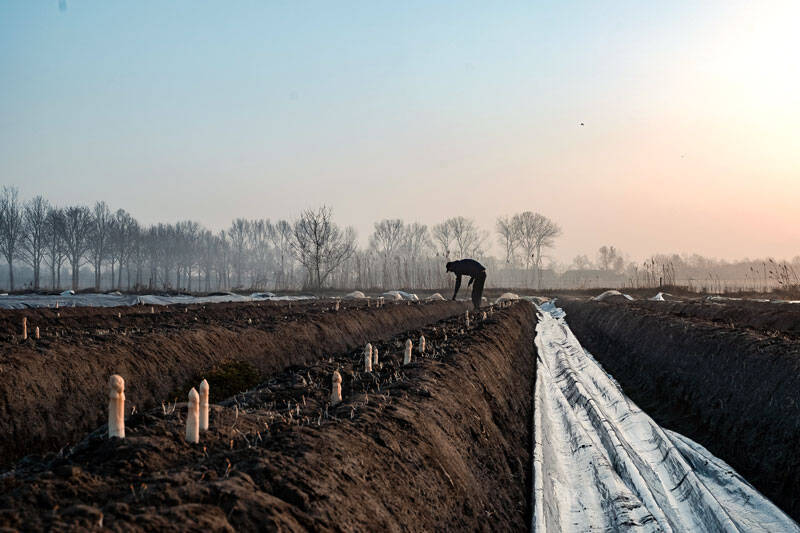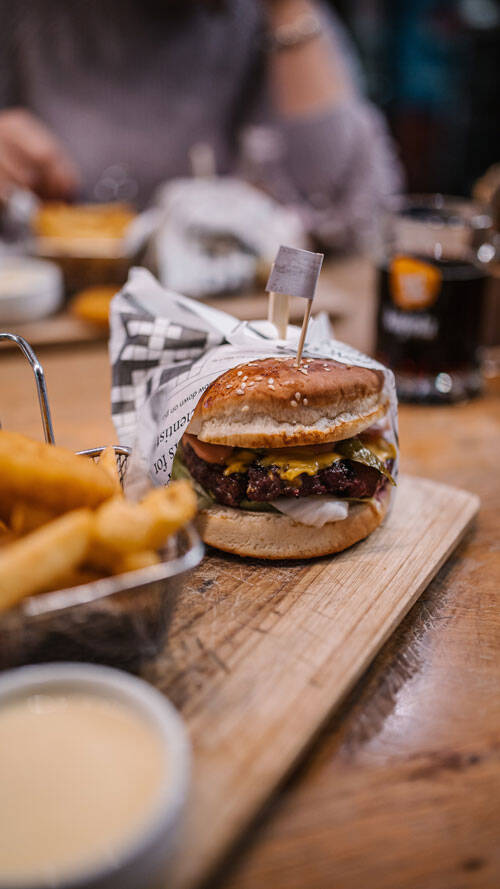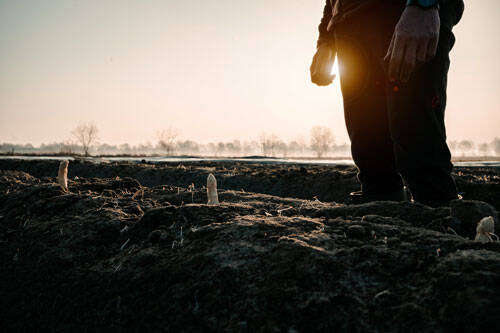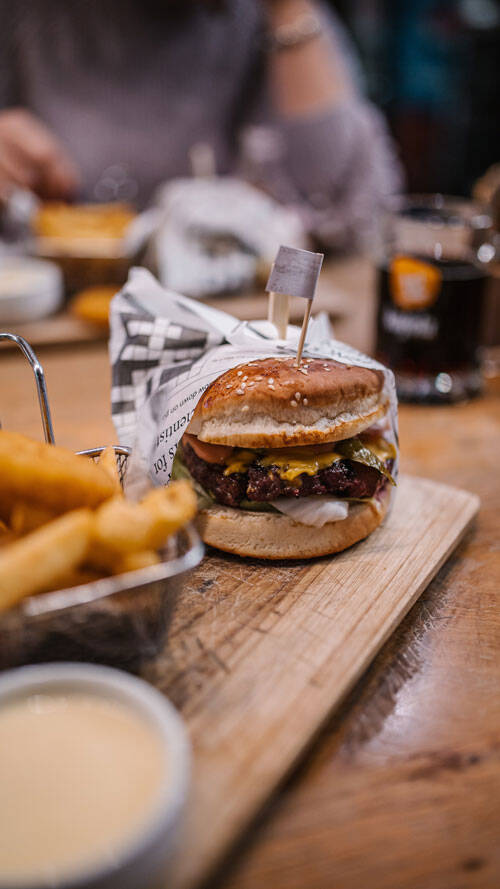For more on food system change see elsewhere in this magazine
Opportunity for change
The COVID-19 pandemic may be an opportunity and galvanizing moment to promote this new kind of food system. A system that champions local producers and supply chain resilience. A system that reduces our reliance on ultraprocessed food in favor of affordable, sustainable healthy food. To get there will need concerted effort from industry leaders and governments, but it can be done. 2020 has more than ever exposed the fundamental flaws in our food system. We cannot in good conscience go back to the way we did things before.
© Floris Heuer

© Floris Heuer

Chef Poul Andrias Ziska, © Floris Heuer

Cultivating resilience
In an interview with Time magazine, Dan Barber, chef and owner at Blue Hill at Stone Barns and champion of the farm-to-table movement said that the coronavirus crisis exposed some fundamental weaknesses in the system. Exclusivity and a focus on foodservice as the sole bastion of hyperlocal, quality products is the wrong way to go about it. Barber: “What we need to do is design a whole new regional food system that can withstand these shocks and others that will come along.”
Chef Poul Andrias Ziska, who works at two Michelin star restaurant KOKS on the remote Faroe Islands and as such is almost completely dependent on local producers, echoes Barber’s sentiments: “We need to somehow convince people to eat less, but better quality. If the food we eat at home is the same as what we eat in a restaurant, then the local fisherman and brewer and farmer who dedicate their lives to making products of the highest quality would have a better chance of surviving a crisis like this.”

Ultraprocessed food is easy and convenient and comforting and exactly what you might feel you need in times of monumental uncertainty. It’s also a serious health risk
What do we eat in a new normal?
This surge in demand for ultraprocessed food is likely to be temporary. The long running trend towards healthy diets will in time reclaim the spotlight as we return to a new normal. In fact, the relationships between our industrial food system and the risks and consequences of pandemics will be evaluated anew. Does our diet make us more susceptible to diseases? Is our dependence on products from halfway around the world sustainable at all? What must we do to make our food system more resilient?
The rise of these new narratives will take time however, and during that time, local artisanal food producers are at risk and must be safeguarded. These hyperlocal producers are often highly dependent on foodservice, and with foodservice taking a severe economic beating thanks to COVID-19, the supply chain is endangered. For a potential solution we can look at the innovators in high end gastronomy.
© Nina Slagmolen

© Nina Slagmolen

Delivery and comfort
Let’s start with the rising consumer demand for ultraprocessed food. This is in line with Food Inspiration’s predictions of how consumers respond to the pandemic. The first phase of recovery is characterized by a temporary hedonism. People will opt for the reliable, safe, and comforting food options. More often than not this means ultraprocessed food you find in supermarkets and fast food restaurants. In foodservice, the menus filled with the most comfort food will find the most success early on.
A second related explanation is the meteoric rise of takeaway and delivery food options. The restaurants and chains that were already set up
for maximum efficiency often carry items filled with the unhealthy fats, salt, sugar, preservatives and other hallmarks of ultraprocessed food. When delivery demand rose as a consequences of national and regional lockdowns, these companies were best equipped to scale up even further. America’s four largest pizza chains, for example, are hiring a combined 60,000 people to meet delivery demand. Ultraprocessed food is easy and convenient and comforting and exactly what you might feel you need in times of monumental uncertainty. The reality is that an unhealthy diet may put you at a serious health risk.


The COVID-19 pandemic may be an opportunity to promote a new kind of food system that champions local producers and supply chain resilience
Jelle Steenbergen Xiao Er Kong
A recent study from the Center of Disease Control points to obesity as the biggest risk factor for COVID-19 death in people under fifty. Despite that, ultraprocessed food, a major component of poor diets, is having a moment in the sun. At the same time local artisanal producers dependent on supplying their products to foodservice are struggling. What does the future hold?
COVID-19 TEACHES US: WE HAVE TO EAT LESS, BUT BETTER FOOD
The future of ultraprocessed food
TRENDWATCH
4 min
THE FUTURE OF ULTRAPROCESSED FOOD

© Nina Slagmolen
© Nina Slagmolen
© Floris Heuer
© Floris Heuer
For more on food system change see elsewhere in this magazine
Opportunity for change
The COVID-19 pandemic may be an opportunity and galvanizing moment to promote this new kind of food system. A system that champions local producers and supply chain resilience. A system that reduces our reliance on ultraprocessed food in favor of affordable, sustainable healthy food. To get there will need concerted effort from industry leaders and governments, but it can be done. 2020 has more than ever exposed the fundamental flaws in our food system. We cannot in good conscience go back to the way we did things before.


Cultivating resilience
In an interview with Time magazine, Dan Barber, chef and owner at Blue Hill at Stone Barns and champion of the farm-to-table movement said that the coronavirus crisis exposed some fundamental weaknesses in the system. Exclusivity and a focus on foodservice as the sole bastion of hyperlocal, quality products is the wrong way to go about it. Barber: “What we need to do is design a whole new regional food system that can withstand these shocks and others that will come along.”
Chef Poul Andrias Ziska, who works at two Michelin star restaurant KOKS on the remote Faroe Islands and as such is almost completely dependent on local producers, echoes Barber’s sentiments: “We need to somehow convince people to eat less, but better quality. If the food we eat at home is the same as what we eat in a restaurant, then the local fisherman and brewer and farmer who dedicate their lives to making products of the highest quality would have a better chance of surviving a crisis like this.”
Chef Poul Andrias Ziska, © Floris Heuer


Ultraprocessed food is easy and convenient and comforting and exactly what you might feel you need in times of monumental uncertainty. It’s also a serious health risk
What do we eat in a new normal?
This surge in demand for ultraprocessed food is likely to be temporary. The long running trend towards healthy diets will in time reclaim the spotlight as we return to a new normal. In fact, the relationships between our industrial food system and the risks and consequences of pandemics will be evaluated anew. Does our diet make us more susceptible to diseases? Is our dependence on products from halfway around the world sustainable at all? What must we do to make our food system more resilient?
The rise of these new narratives will take time however, and during that time, local artisanal food producers are at risk and must be safeguarded. These hyperlocal producers are often highly dependent on foodservice, and with foodservice taking a severe economic beating thanks to COVID-19, the supply chain is endangered. For a potential solution we can look at the innovators in high end gastronomy.



Delivery and comfort
Let’s start with the rising consumer demand for ultraprocessed food. This is in line with Food Inspiration’s predictions of how consumers respond to the pandemic. The first phase of recovery is characterized by a temporary hedonism. People will opt for the reliable, safe, and comforting food options. More often than not this means ultraprocessed food you find in supermarkets and fast food restaurants. In foodservice, the menus filled with the most comfort food will find the most success early on.
A second related explanation is the meteoric rise of takeaway and delivery food options. The restaurants and chains that were already set up for maximum efficiency often carry items filled with the unhealthy fats, salt, sugar, preservatives and other hallmarks of ultraprocessed food. When delivery demand rose as a consequences of national and regional lockdowns, these companies were best equipped to scale up even further. America’s four largest pizza chains, for example, are hiring a combined 60,000 people to meet delivery demand. Ultraprocessed food is easy and convenient and comforting and exactly what you might feel you need in times of monumental uncertainty. The reality is that an unhealthy diet may put you at a serious health risk.

The COVID-19 pandemic may be an opportunity to promote a new kind of food system that champions local producers and supply chain resilience
Jelle Steenbergen Xiao Er Kong
A recent study from the Center of Disease Control points to obesity as the biggest risk factor for COVID-19 death in people under fifty. Despite that, ultraprocessed food, a major component of poor diets, is having a moment in the sun. At the same time local artisanal producers dependent on supplying their products to foodservice are struggling. What does the future hold?
COVID-19 TEACHES US: WE HAVE TO EAT LESS, BUT BETTER FOOD
The future of ultraprocessed food
4 min









